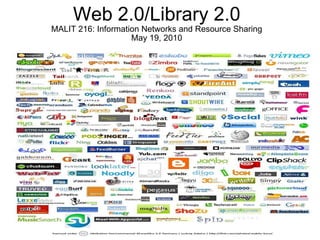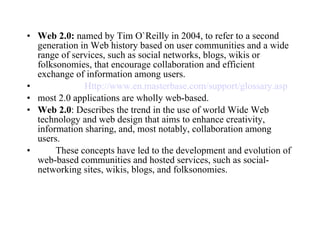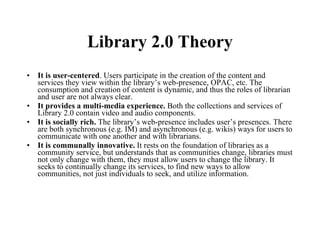Web 2.0/Library20
- 1. Web 2.0/Library 2.0 MALIT 216: Information Networks and Resource Sharing May 19, 2010 Daniel Lopatin Pratt SILS 11.30.09
- 2. Web 2.0: named by Tim O`Reilly in 2004, to refer to a second generation in Web history based on user communities and a wide range of services, such as social networks, blogs, wikis or folksonomies, that encourage collaboration and efficient exchange of information among users. Http:// www.en.masterbase.com/support/glossary.asp most 2.0 applications are wholly web-based. Web 2.0 : Describes the trend in the use of world Wide Web technology and web design that aims to enhance creativity, information sharing, and, most notably, collaboration among users. These concepts have led to the development and evolution of web-based communities and hosted services, such as social-networking sites, wikis, blogs, and folksonomies.
- 3. WEB 2.0... What's The Deal? The term " Web 2.0 " is commonly associated with web applications that facilitate interactive information sharing, interoperability, user-centered design and collaboration on the World Wide Web. Examples of Web 2.0 include web-based communities, hosted services, web applications, social-networking sites, video-sharing sites, wikis, blogs, mashups and folksonomies. A Web 2.0 site allows its users to interact with other users or to change website content, in contrast to non-interactive websites where users are limited to the passive viewing of information that is provided to them. ( http://en.wikipedia.org/wiki/Web_2.0 ) 1.0 2.0 Online encyclopedias --> Wikipedia personal websites --> blogging directories --> tagging (taxonomy) ("folksonomy") stickiness --> syndication publishing --> participation (static media) (social media}
- 4. Some examples of the move from Library1.0 to Library 2.0 include: Email reference/Q&A pages ---> Chat reference Text-based tutorials ---> Streaming media tutorials with interactive databases Email mailing lists, webmasters ---> Blogs, wikis, RSS feeds Controlled classification schemes ---> Tagging coupled with controlled schemes OPAC ---> Personalized social network interface Catalog of largely reliable print and electronic holdings ---> Catalog of reliable and suspect holdings, web-pages, blogs, wikis, etc
- 5. What do we mean by "Social Media" ? Social media is media designed to be disseminated through social interaction, created using highly accessible and scalable publishing techniques . It supports the democratization of knowledge and information, transforming people from content consumers into content producers. Andreas Kaplan and Michael Haenlein define social media as "a group of Internet-based applications that build on the ideological and technological foundations of Web 2.0 and that allow the creation and exchange of user-generated content. Social media uses Internet and web-based technologies to transform broadcast media monologues (one to many) into social media dialogues (many to many). http:// en.wikipedia.org/wiki/Social_media
- 6. Social Media in a Library Context: Rationale Raises awareness and promotes the library in terms of its available services and programs Manages the library’s brand and reputation and further disseminates the library's mission statement message (outbound PR). Generates ideas for library improvements via crowdsourcing. Provides frameworks for user-generated content. Builds stronger customer service communication lines with patrons (and provides good data regarding patron usage via web metrics) SOCIAL MEDIA ENABLES COMMUNITY BUILDING SURROUNDING YOUR INSTITUTION'S PRACTICES!
- 7. Library 2.0: The application of interactive, collaborative, and multi-media web-based technologies to web-based library services and collections.
- 8. Library 2.0 Theory It is user-centered . Users participate in the creation of the content and services they view within the library’s web-presence, OPAC, etc. The consumption and creation of content is dynamic, and thus the roles of librarian and user are not always clear. It provides a multi-media experience. Both the collections and services of Library 2.0 contain video and audio components. It is socially rich. The library’s web-presence includes user’s presences. There are both synchronous (e.g. IM) and asynchronous (e.g. wikis) ways for users to communicate with one another and with librarians. It is communally innovative. It rests on the foundation of libraries as a community service, but understands that as communities change, libraries must not only change with them, they must allow users to change the library. It seeks to continually change its services, to find new ways to allow communities, not just individuals to seek, and utilize information.
- 9. Tenets of Library 2.0 it allows a user presence within the library web-presence; it allows collaboration between patrons and librarians; and it allows a more dynamic experience. Becoming a more web-based application (they often allow co-browsing, file-sharing, screen-capturing and data sharing
- 10. Synchronous Messaging widely known as instant messaging (IM). Libraries have begun to provide “chat reference” services, where patrons can synchronous communicate with librarians much as they would in a face-to-face reference context. Streaming media are multimedia that are constantly received by, and normally presented to, an end-user while being delivered by a streaming provider (the term "presented" is used in this article in a general sense that includes audio or video playback). The name refers to the delivery method of the medium rather than to the medium itself. The distinction is usually applied to media that are distributed over telecommunications networks , as most other delivery systems are either inherently streaming (e.g., radio , television ) or inherently non-streaming (e.g., books , video cassettes , audio CDs ). The verb 'to stream' is also derived from this term, meaning to deliver media in this manner. Internet television is a commonly streamed medium.
- 11. Blogs and Wikis A Blog is a type of website usually maintained by an individual with regular entries of commentary, descriptions of events, or other material such as graphics or video. Entries are commonly displayed in reverse-chronological order. Blog can also be used as a verb, meaning to maintain or add content to a blog. Many blogs provide commentary or news on a particular subjects; others functions more personal online diaries. Wikis are essentially open web-pages, where anyone registered with the wiki can publish to it, and change it. the lack of peer review and editorship is a challenge to librarians, not in that users should
- 12. Social Network Social networks enable messaging, blogging, streaming media, and tagging. Tagging enables users to crate subject headings for the object at hand. Users could tag the library’s collection and thereby participate in the collection process. Tags and standardized subjects are not mutually exclusive. The catalog of Library 2.0 would enable users to follow both standardized and user-tagged subjects.
- 13. RSS Feeds - Really Simple Syndication – to make it easier to keep track of changes. - An RSS document (which is called a “feed” includes full or summarized text, plus metadata such as publishing dates and authorship. They benefit readers who want to subscribe to timely updates from favored websites. Mashups they are ostensibly hybrid applications, where two or more technologies or services are conflated into a completely new novel service. Retrivr, for example conflates Flickr's image database and an experimental information architecture algorithm to enable users to search images not by metadata, but by the data itself. Users search for images by sketching images. In some ways, many of the technologies discussed above are mashups in their very nature. Another example is WikiBios , a site where users create online biographies of one another, essentially blending blogs with social networks
- 23. Library 2.0 is completely user-centered and user-driven. It is a mashup of traditional library services and innovative Web 2.0 services. It is a library for the 21st century, rich in content, interactivity, and social activity. Library 2.0 is not about searching, but finding; not about access, but sharing.























